 When Tanya, a contributer at The Well-Read Child, and blogger at books4yourkids.com enthusiastically told me about how passionate she was about this book, I couldn't wait to share her review with you. I hope you enjoy it! Thanks Tanya!
When Tanya, a contributer at The Well-Read Child, and blogger at books4yourkids.com enthusiastically told me about how passionate she was about this book, I couldn't wait to share her review with you. I hope you enjoy it! Thanks Tanya!
Ellen Potter is the creator of my favorite clairvoyant sleuth,
Olivia Kidney, who now has three books to her name. She has also written
Pish Posh, which also involves some serious detective work on the part of main character Clara Frankofile. With
SLOB we have the honor of meeting Owen Birnbaum, a narrator who is one point shy of having a genius IQ, which is what he tells people because his mother told him long ago to stop telling people what his actual IQ is. Owen is also 57% fatter than the average twelve-year-old boy and completely endearing, flaws and all. Owen's story is the kind that you want to relate from beginng to end to the closest warm body - like you feel after seeing a really great movie with someone other than your best friend or spouse. Fortunatley, I was able to to convince my husband, sixteen-year old daughter and eleven-year old son (who chooses not to read fiction, despite my cajoling and bribes) to read
SLOB so that we could all talk about it together. It wasn't a hard sell, even to my son... Alas, there are some brilliant twists in this remarkable new book that I didn't see coming and I don't want to spoil them for anyone else. So, I'll try to stick to describing the true-to-life characters and spot-on details that Ellen Potter has woven into this bittersweet story without revealing too much, even though I am bursting to tell you everything.
Owen's voice is so real that I can't help but be reminded of other great literary and cinematic characters when I think of him. Owen reminds me a bit of the underachieveing and overweight Jack, one of the three main characters in Wendy Mass' poignant and astronomical book,
Every Soul a Star. The rich, unique details that pepper
SLOB also call to mind the quirks in another Wendy Mass book,
Jeremy Fink and the Meaning of Life. However, despite my comparisons to the works of Wendy Mass, another favorite young adult author of mine writing fiction with a contemporary, realistic setting, Ellen Potter's story is entirely her own. Well, really it is Owen's story from start to finish.
It took the act of writing about books I have read and loved to help me to realize that as an adult reader of young adult fiction, I have a totally different set of qualities that appeal to me and this criteria is probably very different from that of a child reader. And, while I realize that it is mostly adults who are reading my reviews, I do always try to imagine what, say, the eleven-year-old me would have found appealing or boring about a book as well as the qualities that I, the adult reader find engaging. As an adult, I wanted to give Owen a big hug by the end of the book. He made me laugh out loud and cry and, while I would love it if one of my children had an IQ one point shy of genius, I would be especially honored if I was the parent of a child who overcame the hurdles and obstacles that were thrown at Owen with the courage and selflessness that he showed in the pages of SLOB. The eleven-year old me would have also laughed out loud at Owen and been drawn to the complete, three dimensional character that he is thanks to wholehearted, empathetic writing on Ellen Potter's part. There were times in the book when Owen's narrative voice reminded me so much of another (probably misguided on my part) adolescent hero of mine, Holden Caufield from JD Salinger's The Catcher in the Rye. And, while Owen is not self-destructive or deluded in the ways that Holden is, he is self-deprecating and innocent and genuinely cares about the welfare of those he loves. And, like Holden, Owen is a great, if not always reliable observer and describer of everyone and everything around him.
The bare bones plot of SLOB involve Owen's efforts to complete the construction of Nemesis, a satellite dish, a receiver, a television set and a mass of coils that he has been working on for a year and a half. As Owen says in his direct, perceptive and practical manner, "I'm not going to tell you what she will do once she's complete. You don't know me well enough yet. You probably think you do. Everyone thinks they know the fat kid. We're so obvious. Our embarrassing secret is out there for everyone to see, spilling over our belts, flapping under our chins, stretching the seams of our jeans." Owen also has to deal with Mr Wooly, a PE teacher who is "a few fries short of a Happy Meal" as well as someone who is stealing the three Oreos packed in an eco-container "which is made of recycled shower curtains (I'm not kidding, they really are made from shower curtains)" and stored inside his cloth lunch sack - his one indulgence in his otherwise healthy, low-fat diet. Finding the Oreo thief leads Owen down a dangerous path and a confrontation with both Mr Wooly and Mason Ragg, the new kid in school with a horrible burn scar on his face who may or may not carry a switchblade in his sock.
This is really just the tip of the iceberg for Owen, though. Nima, a Tibetan who immigrated to New York City and now lives in Owen's building provides a safe haven and a wise voice, sharing his thoughts on karma and Buddhism with Owen as well as his leftover momos, handmade dumplings that he sells from a cart in front of the Natural History Museum during the day. Izzy, Owen's gargantuan best friend also proves to have a lot more going on inside than appearances let on. And, without giving too much away, I need to mention the profoundly moving and subtle story arc in SLOB that builds over the course of the book. But, before I leave you with a spoiler alert I need to say that, being a reader who prefers fantasy over reality based fiction, I am rarely wowed and won over by a book of this nature. And, before I started reviewing I rarely even read this kind of book. Since then, I have been honored to read a handful of really remarkable kid's books of this genre that will stick with me the rest of my life and I am thrilled to add SLOB to that list. Like Holden says in The Catcher in the Rye, "What really knocks me out is a book that, when you're all done reading it, you wish the author that wrote it was a terrific friend of yours and you could call him up on the phone whenever you felt like it." Ellen Potter is an author I wouldn't mind discussing a few things with, but really, by the time I finished SLOB, I wished that Owen was a friend of mine I could call up and talk about the world with.
*****SPOILER ALERT******
It turns out that Mom is not Owen's birth mother but a woman who adopted him and his sibling after their parents were murdered. Well into the plot, while visiting with Nima, Owen shares the details of their deaths and his reasons for building Nemesis, which dovetails nicely with a story thread involving his sibling. And, while Owen is a genuinely enthralling character, his sibling, one year younger he is, is also vividly written and almost as captivating. When we first see Owen meeting up with his younger sibling to walk home from school, we assume that Jeremy is a boy. However, we soon learn that Jeremy is a girl with long, red hair and skinny wrists who has joined GWAB - Girls Who Are Boys. This is a club that requires its members to get boy haircuts, dress like boys and assume boy names. The president of the group is Arthur, who looks very boyish and is always wears a read polo shirt and khakis because her mother refuses to buy her any real boy clothing. Somehow, Jeremy has managed to subvert the haircut requirement and stay in the club. Jeremy, who's real name is Caitlin, proves to be just as interesting a character as her big brother and manages to play a significant part in his story. Jeremy, GWAB and their Blue and White Rebellion represent a plot thread that I have never seen in young adult literature before but find completely realistic and fascinating. Perhaps because they are eleven, the girls in GWAB manage to be fierce and independent within the story and remain innocent. In the back of my mind, I expected anti-gay slurs to be hurled at them at some point, but the tone of
SLOB is such that that was never an issue.
Originally posted by Tanya at books4yourkids.com May 13, 2009.













